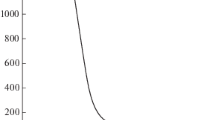Abstract
This paper presents a novel method of fracture toughness determination, - a method that does not require introduction of an initial crack or notch-type defect in a sample. The corresponding formula for calculating fracture toughness, which does not depend on crack length is derived. This “express” test is useful for industrial applications because it economical and may be used for a wide range of brittle materials from ceramics to concrete and rocks. Test results are shown to be in good accord with the results obtained by ASTM methods.
Similar content being viewed by others
REFERENCES
Friedman, M., Haudin, I., and Alani, G. (1972). Fracture Surface Energy of Rocks. International. Journal of Rock Mechanics and Mining Science. 9,No 6, pp. 757–766.
Hertzberg, R. W. (1983). Deformation and Fracture Mechanics of Engineering Materials. New York, John Wiley & Sons
Isida, M. (1975). Arbitrary Loading Problems of Doubly Symmetric Regions Containing a Central Crack. Engineering Fracture Mechanics 7, pp. 505–51
Jaeger, J. C. and Cook, N. G. W. (1983). Fundamentals of Rock Mechanics. London, Chapman & Hall.
Murakami, Y., Kisine, N., and Tsuru, H. (1986). Stress Intensity Factors for Cracks Emanating from a Circular Hole in Circular Disk under Diametral Compression. Transactions of Japan Society of Mechanical Engineers 52,No 480.
Murakami Y. (Editor) (1987). Stress Intensity Factors Handbook. Vol. 1, Pergamon Press.
Muskhelishvili, N. I. (1963). Some Basic Problems of The Mathematical Theory of Elasticity. Erven P. Noordhoff, NV, Groningen, Netherlands
Nisitani, H. and Mori, K. (1985). Influence of Supporting Conditions on Stress Intensity Factors for Single-Edge-Cracked Specimens under Bending. Technical Report of Kyushu University 58 No 5, pp. 751–755.
Ripperger, E. A., and Davids, N. (1947). Critical Stresses in a Circular Ring. Transactions of ASCE 112 pp. 619–628
Staroselsky, A. V., Chirkov, S. E., Shobolova, L. P., and Edelshtein, O. A., (1990). The Influence of Surface Active Substances on Crack Resistance of Hard Rocks. Soviet Mining Sciences. 5, pp. 32–35
Timoshenko, S. P., and Goodier, J.N. (1970). Theory of Elasticity. McGraw-Hill, Inc.
Author information
Authors and Affiliations
Rights and permissions
About this article
Cite this article
Staroselsky, A. The Express Method of Determining the Fracture Toughness of Brittle Materials. International Journal of Fracture 98, 47–52 (1999). https://doi.org/10.1023/A:1018704916068
Issue Date:
DOI: https://doi.org/10.1023/A:1018704916068




